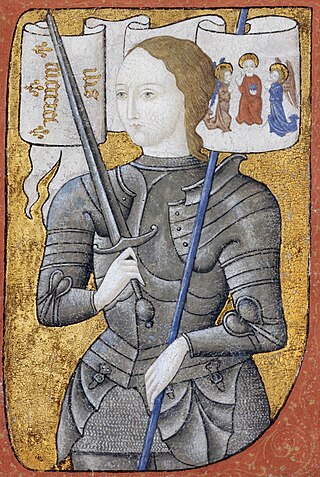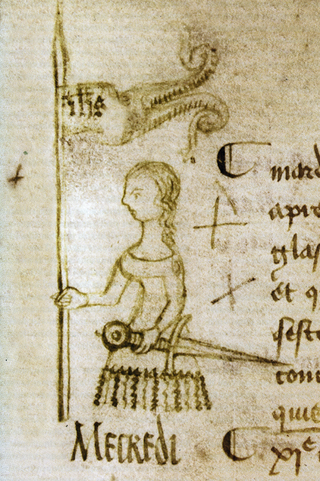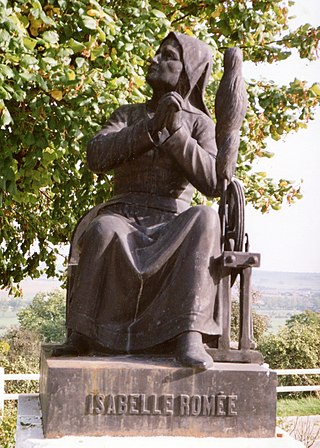
Christine de Pizan or Pisan, was an Italian-born French poet and court writer for King Charles VI of France and several French dukes.

Joan of Arc is a patron saint of France, honored as a defender of the French nation for her role in the siege of Orléans and her insistence on the coronation of Charles VII of France during the Hundred Years' War. Claiming to be acting under divine guidance, she became a military leader who transcended gender roles and gained recognition as a savior of France.

The Book of the City of Ladies, or Le Livre de la Cité des Dames, is a book written by Christine de Pizan believed to have been finished by 1405. Perhaps Pizan's most famous literary work, it is her second work of lengthy prose. Pizan uses the vernacular French language to compose the book, but she often uses Latin-style syntax and conventions within her French prose. The book serves as her formal response to Jean de Meun's popular Roman de la Rose. Pizan combats Meun's statements about women by creating an allegorical city of ladies. She defends women by collecting a wide array of famous women throughout history. These women are "housed" in the City of Ladies, which is actually the book. As Pizan builds her city, she uses each famous woman as a building block for not only the walls and houses of the city, but also as building blocks for her thesis. Each woman introduced to the city adds to Pizan's argument towards women as valued participants in society. She also advocates in favour of education for women.

Marie de France was a poet, possibly born in what is now France, who lived in England during the late 12th century. She lived and wrote at an unknown court, but she and her work were almost certainly known at the royal court of King Henry II of England. Virtually nothing is known of her life; both her given name and its geographical specification come from manuscripts containing her works. However, one written description of her work and popularity from her own era still exists. She is considered by scholars to be the first woman known to write francophone verse.

Pearl is a late 14th-century Middle English poem that is considered one of the most important surviving Middle English works. With elements of medieval allegory and from the dream vision genre, the poem is written in a North-West Midlands variety of Middle English and is highly—though not consistently—alliterative; there is, among other stylistic features, a complex system of stanza-linking.
Envoi or envoy in poetry is used to describe:

The Passion of Joan of Arc is a 1928 French silent historical film based on the actual record of the trial of Joan of Arc. The film was directed by Carl Theodor Dreyer and stars Renée Jeanne Falconetti as Joan. It is widely regarded as a landmark of cinema, especially for its production, Dreyer's direction and Falconetti's performance, which is often listed as one of the finest in cinema history. The film summarizes the time that Joan of Arc was a captive of England, depicting her trial and execution.

Joan of Arc is a 1948 American hagiographic epic film directed by Victor Fleming, and starring Ingrid Bergman as the eponymous French religious icon and war heroine. It was produced by Walter Wanger and is based on Maxwell Anderson's successful Broadway play Joan of Lorraine, which also starred Bergman, and was adapted for the screen by Anderson himself, in collaboration with Andrew Solt. It is the only film of an Anderson play for which the author wrote the film script. It is the last film Fleming directed before his death in 1949.

Medieval French literature is, for the purpose of this article, Medieval literature written in Oïl languages during the period from the eleventh century to the end of the fifteenth century.
Fresh Verdicts on Joan of Arc is an anthology of scholarly essays on Joan of Arc. First published by Garland publishing in 1996 (ISBN 0-8153-3664-0), it is 336 pages long.

There are a number of revisionist theories about Joan of Arc which contradict the established account of her life. These include the theories she was an illegitimate royal child; that she was not burned at the stake; that most of her story is a fabrication; and that she escaped death at the stake. These theories have not gained significant acceptance among academic historians.

Isabelle Romée, also known as Isabelle de Vouthon and Isabelle d'Arc (1377–1458) and Ysabeau Romee, was the mother of Joan of Arc. She grew up in Vouthon-Bas and later married Jacques d'Arc. The couple moved to Domrémy, where they owned a farm consisting of about 50 acres (200,000 m2) of land. After their daughter's famous exploits in 1429, the family was granted noble status by Charles VII in December of that year. Isabelle moved to Orléans in 1440 after her husband's death and received a pension from the city. She petitioned Pope Nicholas V to reopen the court case that had convicted Joan of heresy, and then, in her seventies, addressed the opening session of the appellate trial at Notre Dame cathedral in Paris. The appeals court overturned Joan's conviction on 7 July 1456. Isabelle died two years later, probably at Sandillon near Orléans.
Pierronne, also known as Pierrone, Pierronne la Bretonne and Perrinaïc, was a Breton woman who said she saw visions of "God dressed in a long white robe with a red tunic underneath". Pierronne, who may have met Joan of Arc in 1429, tried to defend her reputation at Corbeil. For this, Pierronne was arrested by pro-English authorities in March 1430 and burned at the stake.

Due to inconsistent record keeping and different contemporary customs, the name of Joan of Arc at birth is not known for certain.
Madeleine Des Roches was a French writer of the Renaissance. She was the mother of Catherine Fradonnet, called Catherine Des Roches, to whom she taught poetry, literature and ancient languages. She is a writer in the tradition of Christine de Pizan and others, working to establish a community of women writers.

Jacquesd'Arc was a farmer from Domrémy, France who was the father of the French military leader and Catholic saint Joan of Arc. D'Arc is most known for being an influence on his daughter Joan's life, developing her leadership abilities through his example as a local government and military leader as well as restricting her ambitions with his controlling behaviour that resulted in a strained relationship between them.
Le livre du chemin de long estude is a first-person dream allegory by Christine de Pizan. Composed in 1402–03, it presents a critique of the moral state of the world and particularly France, lamenting the results of warfare.
Constance de Rabastens (13??–1386) was one of the female visionaries who concerned herself with politics in the late fourteenth century. Many visionaries emerged in the late fourteenth century that predicted the future of the Church. Visionaries often claimed that their visions came from God and that the Church should listen to what is being told. Unlike Catherine of Siena and Marie Robine, other visionaries of the Great Schism, Constance was denied any official recognition and Constance at one point had to extract herself from an inquisitorial interrogation only with great difficulty. During the Great Schism there were multiple popes, the pope and the antipope, and Constance's denial of any official recognition was because she endorsed the "wrong" pope through her divinely inspired prophetic pronouncements. Little is known about Constance's life as her confessor, Raymond de Sabanac, decided not to write about her life and decided to only write about her visions. Although there are not much known about Constance's life, there are documents about her visions and the letters she wrote to the inquisitor of Toulouse that are preserved in a Catalan translation in Bibliothèque nationale de France. Most of Constance's visions were put together by her confessor, Raymond de Sabanac, but some series of visions were transmitted to Raymond by Constance's son.

After the French lifted the siege of Orléans and won a decisive victory at the Battle of Patay, the English and Burgundians no longer posed a threat. Joan of Arc convinced the Dauphin Charles to go to Reims for his coronation. Successfully marching their army though the heart of territory held by the hostile Burgundians solidified the Dauphin’s regrasp of the throne of France. He had been disinherited from it through the Treaty of Troyes.
Marie Robine, also known as Marie of Avignon or Marie the Gasque, was a French mystic who was active during the time of the Western Schism.













